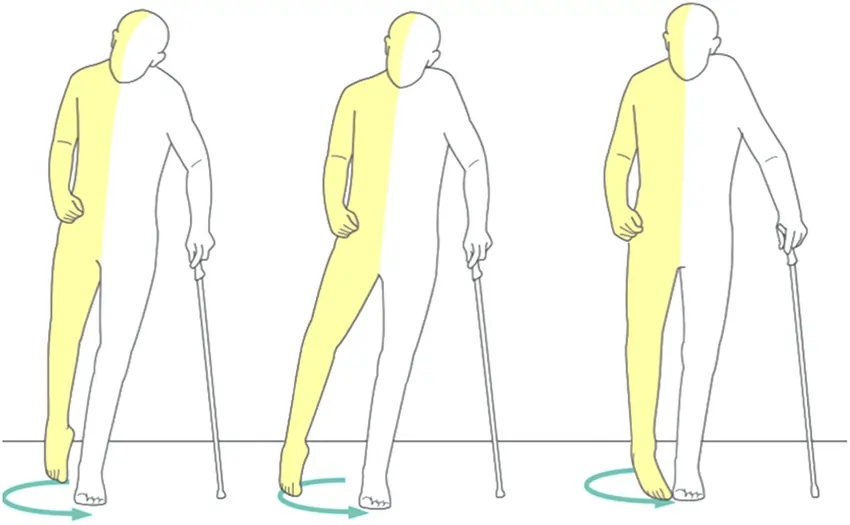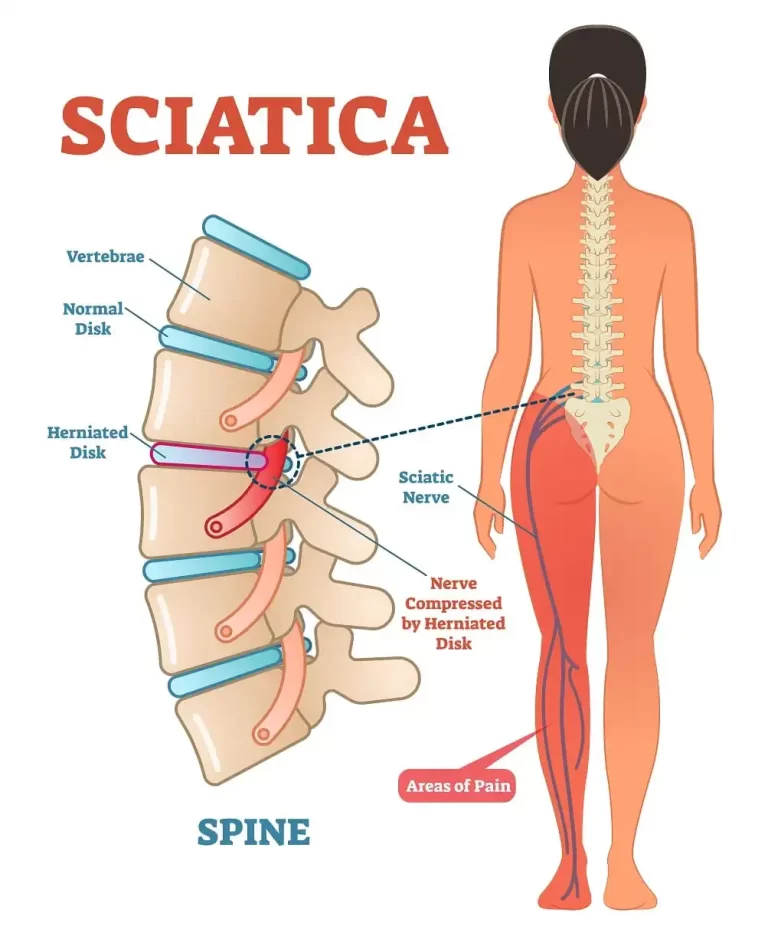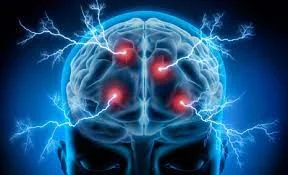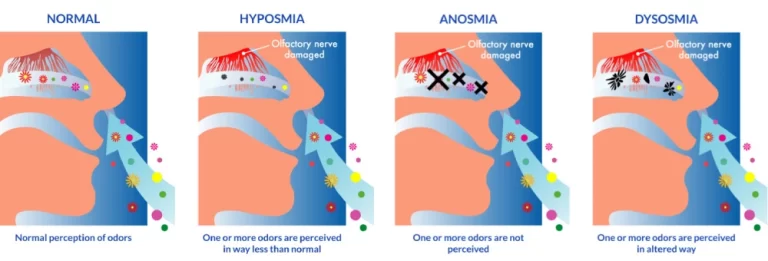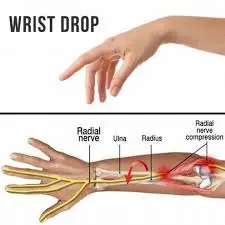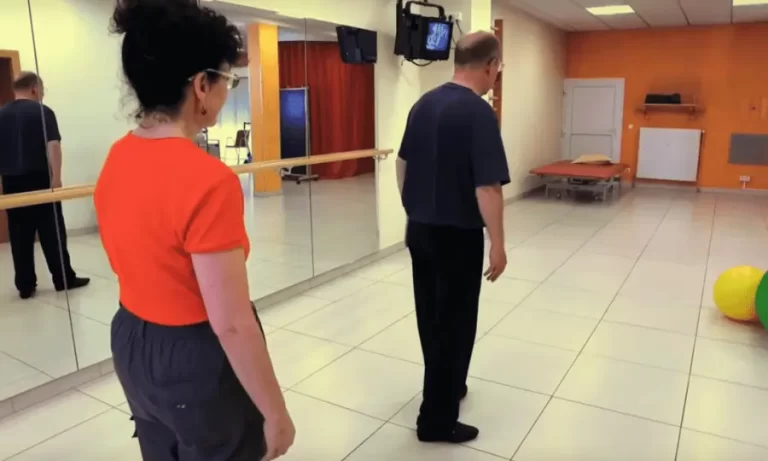Spastic Gait
Introduction
Spastic gait refers to a type of abnormal walking pattern often characterized by stiffness and difficulty in moving the legs due to increased muscle tone. This condition is commonly associated with neurological disorders such as cerebral palsy, multiple sclerosis, stroke, or spinal cord injuries. Individuals with spastic gait may experience tightness in their muscles, resulting in limited joint mobility and awkward movement.
Their ankles and knees will not be able to move normally, and they will drag their toes or feet. Doctors have observed that toddlers with spastic gait show evident limb rigidity and bounce, as well as a propensity for circumduction and foot scratching. In more extreme situations, the adductor muscle tightness causes the legs to cross. Shoes are often designed asymmetrically.
What is Spastic Gait?
- The term spasticity “spas·tic·i·ty” (\spa-‘sti-sə-tē) refers to an atypical elevation in muscular tone or stiffness. Originating from the Latin spatis and the Greek spastikos, which means “afflicted with spasms” and “spaon” (to draw out, stretch), arrives the word spastic. The term “spasms” was used by Hippocrates to refer to epileptic episodes, but the term “spasticity” has only recently been employed.
- Upper motor neuron syndrome includes spasticity, a motor disorder defined by a velocity-dependent increase in tonic stretch responses (muscle tone) with exacerbated tendon jerking due to hyperactivity of the stretch reflex.”
- It’s generally accepted that muscle tone can be defined as the rigidity of the resting muscle or the stiffness or tension the examinee feels when passively stretching a joint while the muscles are moving. When a muscle is relaxed, its tone indicates how resistant it is to passive moves. The tone’s implication is inadequate and ambiguous.
- A person with a spastic gait walks strangely. Children who drag their legs, feet, and toes might compromise their capacity to maintain limb unity.
- Spastic gait is common in children with cerebral palsy, though it can also happen in several other conditions. Weak and tight leg muscles might result in spasmodic gait.
- Often, doctors witness people dragging one leg. This happens when muscles, particularly on one side, stiffen up over an extended period.
- Due to their lack of flexibility, children with this condition are unable to move their knees, ankles, or other joints correctly. They look to walk stiffly because the stiff leg seems to be pulled along when they walk.
What can cause Spastic Gait?
The following illnesses can produce spastic gait:
- Cerebral Palsy(CP)
- Birth Trauma
- Brain Abscess.
- Brain Tumor
- Multiple sclerosis (MS)
- Traumatic brain injury (TBI).
- Stroke
- Various neurological disorders.
- Genetic disorders, such as Sturge-Weber Syndrome
Spastic Gait caused by Cerebral Palsy
It results from harm to the part of the brain that regulates muscle tone and arm and leg movements. Both increased spasticity or tightness of the muscles and decreased flexibility are noted. Leg abnormalities are not present at birth, but rather develop slowly over time. The spastic gait is caused by overly tense, hypertonic muscles that have a restricted range of motion.
Spastic Gait Caused by Multiple Sclerosis
Gait may be impacted by flexor and extensor tightness in this disorder. The hips and knees may bend toward the chest as a result of an involuntary contraction of the hamstring muscles at the rear of the thighs. The stride has the rigidity of spastic walking because of the proximity of the legs and the tight alignment of the hips and knees, which causes the legs to unintentionally straighten when extended.
Spastic Gait Caused by Traumatic Brain Injury
Changes in reflex signals, muscle tone, sensory perception, and movement can result from damage to the brain, cerebellum, or brainstem, which can affect key nerve centers. After a brain injury, a person may have an aberrant posture that resembles a spastic walk, with the ankles flexed but the hips and knees remaining straight.
What are the common Characteristics of Spastic Gait?
- The leg muscles appear rigid and immovable.
- Muscle spasms are abrupt, uncontrollable contractions.
- Having dragging feet makes it difficult to raise your feet off of the floor.
- Walking with crossed or overlapping legs is known as scissoring.
- Walking difficulties
How to Diagnosis Spastic Gait?
To assess your muscular tone and gait, a medical practitioner will do a physical examination. A comprehensive history, a clinical examination, details on pregnancy and delivery concerns, and a record of any trauma, accidents, or other disorders are all required to accurately evaluate spastic gait.
Finding the source of spasticity may be aided by associated studies and imaging evaluations.
- To check for irregularities, the brain and spinal cord are viewed using magnetic resonance imaging (MRI).
- A computed tomography (CT) scan uses X-rays, just like an MRI scan.
- Brain electrical activity can be measured via electroencephalography (EEG).
- To evaluate nerve activity and muscle function, use electromyography (EMG).
What are the treatment for the Spastic Gait?
Doctors examine the following therapeutic options to help patients with Spastic Gait.
- Before taking medicine to relieve the muscular spasms that are common in spasticity, it is important to carefully consider the potential adverse effects.
- Physicians may recommend treatments to lessen spastic gait, such as muscle relaxants or anti-spasticity medications.
- Botulinum toxin (BTA) injections are effective for treating spastic or hyperactive muscles.
- Many medical practitioners recommend physical therapy for those with this walking condition. ‘Passive’ exercise occurs when a second person assists a person with a spastic gait with their movements. Exercises are classified as ‘active’ if they are performed independently by the individual.
- Leg braces can also help a person maintain proper leg and foot posture while standing or walking.
- Shoe splints will provide the same type of assistance.
- A doctor may also recommend a walker for patients with spastic gait who have difficulty maintaining balance.
- Surgical alternatives will be useful in many circumstances. To address underlying issues or increase mobility, surgery may be recommended in some conditions.
What are the Physical therapy for the Spastic Gait?
Physical therapy is essential for treating spastic gait. Its goals are to:
- Reduce pain.
- Improve your muscle flexibility.
- Increase muscle strength.
- Enhance your balance and coordination.
- Improved quality of life.
Common Physical Therapy Methods for Spastic Gait:
- Stretching activities that are gentle might help to improve muscle flexibility and range of motion.
- Exercises for strengthening muscles impacted by spasticity can be strengthened with the aid of resistance training.
- Exercises that test balance, such as walking on a balance beam or balancing on one leg, can help with coordination.
- Physical therapists can assist people with spastic gait in learning how to carry out everyday tasks like cooking and dressing.
- Strength, flexibility, and balance can all be enhanced with low-impact exercises done in the water, a practice known as aquatic therapy.
- Physical therapists can assist people in learning how to utilize assistive devices, like walkers, canes, or braces, to increase their mobility.
Exercises for the Spastic Gait
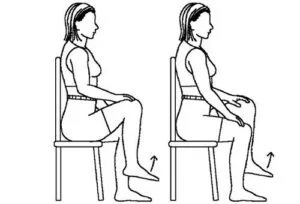
Seated Marching
- Elevate your affected leg to your chest while seated, then return it to the floor.
- Perform 20–30 repetitions switching legs.
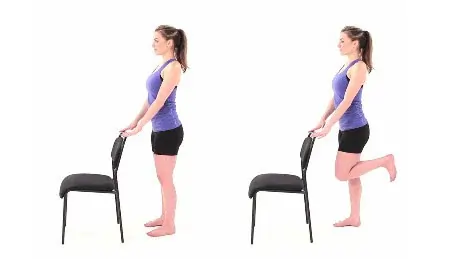
One leg standing
- Practice standing on one leg for five to ten seconds while holding onto a strong chair or desk to improve your balance.
- Repeat ten times, switching up the legs.
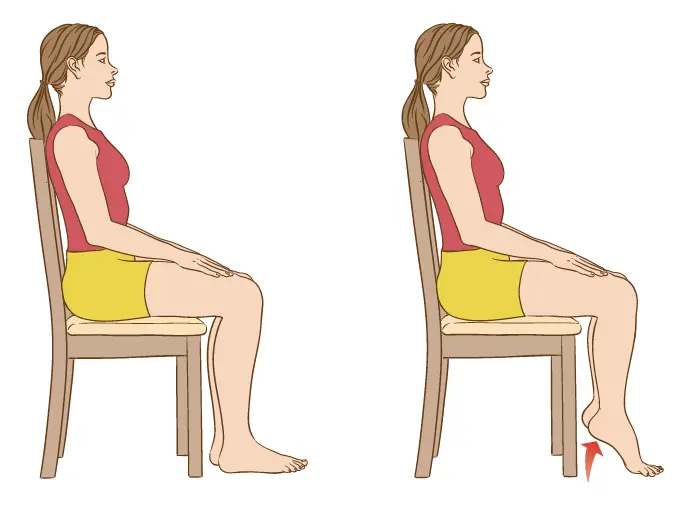
Toe and Heel raises
- Lift your toes off the ground while sitting on a chair, but don’t let go of your heels.
- Pointing your toes is another strategy to raise your heels.
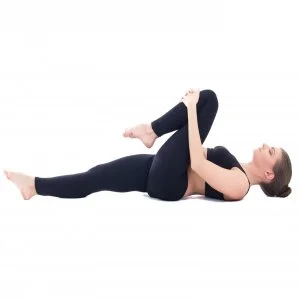
Knee raises
- Bring your legs up to your torso while you’re on your back.
- Make sure to use your core muscles.
- After Performing one side switching legs.
Wall push-ups
- Place your arms against an object, preferably a wall, to alleviate the tension in your wrist muscles.
- Flex your elbows gradually as you bring your upper body closer to the vertical surface. When your head and upper body are almost touching the wall, halt.
- Focus on keeping your body straight as you halt in this stance.
Walking backwards
- Practice walking backward on a treadmill. The belt should initially move slowly. Take a single step back and place your toe. Move to your midfoot after moving to your heel.
Aquatic exercises
- Aquatic exercises are exercises performed underwater.
- Because swimming doesn’t put a strain on joints and requires less effort to move, it can help alleviate spasticity.
Treadmill walking
- When walking on a treadmill, maintain your body weight using a safety harness. Slowly increase your walking speed over a short distance.
Summary
Spastic gait is a walking pattern identified by stiffness and muscle spasms, which are frequently caused by brain or spinal cord injury. Although controlling spastic gait might be challenging, people can usually maintain their independence and enhance their quality of life with the right care.
FAQs
What is a spastic gait?
A spastic gait can be identified by stiffness and bounce in the legs, as well as a tendency to circumduct and scrape the feet. Legs cross in extreme situations because of increased adductor tone. Shoes frequently have an uneven outside wear pattern.
What effects does spasticity have on gait?
Constant muscle stiffness, painful involuntary contractions, and spasms are all signs of spasticity. Walking and other duties may be difficult for someone who has spasticity. Children with spasticity may experience impairment, painful and malformed joints, and growth issues.
What differentiates a scissoring gait from a spastic gait?
People who have spastic diplegia are more likely to have a scissoring gait. When motor deficits mostly affect the legs, this kind of CP arises. Cerebral palsy can cause many different aberrant walking patterns, but the most common one is a scissoring gait.
How is spasticity checked?
The basis for evaluating spasticity should be a clinical evaluation, supplemented by repeated biomechanical and/or electrophysiological measurements made during functional and active movements. The patient must be permitted to evaluate their symptoms as well.
How is a spastic gait treated?
To treat spastic gait, multiple disciplines are frequently involved. It seems that physical treatment is essential for enhancing muscle coordination, strength, and flexibility. Physicians may provide muscle relaxants or anti-spasticity medications to help manage spasticity in spastic gait.
References
- Medical City Children’s Orthopedics & Spine Specialists. (2023b, November 14). Spastic Gait | Walking disorder | We treat this Condition. https://medicalcitykidsortho.com/spastic-gait/
- Wikipedia contributors. (2024, May 21). Spastic gait. Wikipedia. https://en.wikipedia.org/wiki/Spastic_gait#

